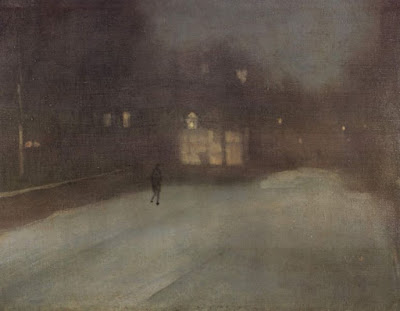Both will be remembered as far more than the sum of their work. We should all aspire to that.
 |
| Jorge, by James Asher, courtesy of the artist’s website. |
When I met painter
Jim Asher, he and his wife,
Joe Anna Arnett, had just learned that he had untreatable esophageal cancer. One would never have known that from their demeanor. They had invited the painters of
Santa Fe Plein Air Fiestato their home, a 1930s adobe that was featured on
This Old House. Despite their personal disaster, they soldiered through.
Jim and I talked briefly about his diagnosis, as I’m a cancer survivor myself. We talked much more extensively about the North Atlantic, which they both knew well and loved.
 |
| Joe Anna Arnett and James Asher, courtesy Santa Fe New Mexican. |
In the normal course of things, I would not have attended his memorial service. However, I was in New Mexico with our mutual friend,
Jane Chapin. It seemed wrong to send her alone.
The service celebrated Jim’s
life’s work, which was notable and well-recognized. But the central theme was love. Jim loved his family, friends, fishing, poetry—and, of course, painting. Others mourned the loss of that love; I walked away with a keen regret that I hadn’t met him decades ago.
That same day, another fine painter,
Walter Lynn Mosley, died on the other side of the country. Walter had been suffering visibly from throat cancer since long before he told the world, growing thinner with each passing month. I knew him from the
Art Students League but mostly kept up with him through my friends in
New York Plein Air Painters, and, of course, on Facebook.
 |
| Walter Lynn Mosley, courtesy Cloud Gallery. |
Walter was a Brooklynite by choice but a Southerner by birth, and it showed in his manner. He was a kind, gentle, man, humble in his very fine painting skills. His graveside service will be private, and his family asks that donations be made in lieu of flowers “to local artists and faith communities in his honor.”
In neither case did my thoughts leap to their work when I heard of their deaths. I thought of the men themselves and of the people they left behind.
Once, a long time ago, I was moaning about some material setback, now long forgotten. “In the end,” my wise friend Toby told me, “what does it matter? We all end up in a recliner in a nursing home somewhere.” Or a hospital bed, or if we’re exceedingly lucky, we can have a quiet death at home.
That is inescapable. None of us take anything with us—not our work, not the encomiums we have earned here on earth, not even a passport stamped with our good works on behalf of others.
 |
| Williamsburg Bridge Sunrise, Walter Lynn Mosley, courtesy artist’s own website. |
“The grave’s a fine and private place/But none, I think, do there embrace,” wrote
Andrew Marvell in the 17
th century. We may have invented a whole new world since then, but that truth remains inescapable. We still must seize the day.
And if we’re remembered as nothing more than painters, we hardly deserve remembering at all.
Jim was, at the end of his life, able to peek through heaven’s doors twice, and he came back to tell his family about it. “The next time, I think I’ll stay,” he told them—and he did.
A week before he died, Walter posted a video on Facebook where he claimed healing through Jesus Christ. You may scoff, but he has that final healing now. Godspeed to both of them, until we meet again.





























